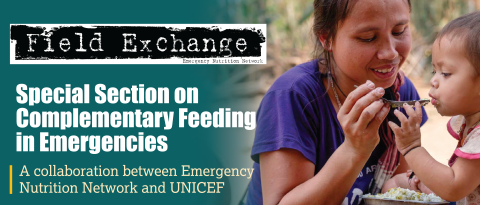Sudan, Nigeria, Myanmar, and Yemen: Lessons from complementary feeding programming in emergencies
Gwénola Desplats is a Senior Nutritionist with ENN.
Jodine Chase is the Infant Feeding in Emergency Core Group Facilitator at ENN.
|
Key messages:
|
Background
The complementary feeding period (6-23 months) is a critical window in a child’s life when ensuring an appropriate diet is important to prevent malnutrition. It is therefore vital to prioritise supporting families with children aged 6-23 months to ensure access to appropriate complementary foods, promote positive feeding practices including continued breastfeeding, and to facilitate optimal growth and development. This is particularly so in emergencies when optimum infant and young child feeding may be jeopardised.
The Infant Feeding in Emergencies Core Group (IFE-CG) provides recommendations for complementary feeding in emergencies (CFE) interventions. In a review of CFE conducted in 2019, the IFE-CG identified that there was a gap in the ‘how-to’ of supporting the diets of young children in emergencies (IFE-CG, 2020). In early 2020, UNICEF launched ‘Programming Guidance for Improving Young Children’s Diets During the Complementary Feeding Period’ (UNICEF, 2020) which provides an Action Framework to improve the diets of children aged 6-23 months. This series of case studies examines the interventions and actions implemented in four fragile contexts1 – Sudan, Nigeria, Myanmar, and Yemen – using the Action Framework as a tool.
Methods
The case studies were undertaken in contexts where some progress towards improving CFE programming had been reported and where a diverse set of key actions and interventions to improve young children’s diets had been documented. We hoped that the learnings from these four countries would provide greater insights for both country-level practitioners and global-level decision-makers on the ‘how to’ of CFE programming and contribute to improving this.
We used a case study methodology to collect information from multiple sources including a country-level document review, an online survey questionnaire, and key informant interviews. We classified data by themes following the logic of the Action Framework. We then reported on the various components of CFE programming that emerged from this analysis.
The findings from each country were presented according to the structure and themes of the UNICEF Programming Guidance (Box 1).
Box 1: Summary of the UNICEF Programming Guidance themes and components
Programming context
Programming context is defined as the setting in which the country programming is being implemented, considering contextual features such as emergencies and food security. The Action Framework (and actions to improve the diets of young children) should be adapted and expanded according to the country context.
Nutrition situation analysis: Drivers and determinants of young children’s diets
Conducting a situation analysis is important to design effective complementary feeding programmes. The situation analysis should include an examination of existing barriers and bottlenecks that may negatively affect complementary feeding programming. Coordination should occur within and across sectors including strengthening multi-sector planning and clearly defining the roles of different actors. Understanding the policy environment and legal frameworks driving complementary feeding outcomes is a key action.
Interventions and actions for improving young children’s diets
Key interventions for improving young children’s diets are recommended based on available evidence. These are suggested to be implemented via different channels/systems including health, food, social protection and water, sanitation, and hygiene and at multiple levels (policy, institutional and community/household).
Monitoring, evaluation, learning, and reported outcomes
Monitoring, evaluation, and learning is critical to effective programme implementation and the achievement of programme objectives.
Outcomes
The Action Framework was a useful tool for this exercise as it provided structure to the different components and stages of CFE programming and identified potential opportunities at different levels, through various channels. It may therefore be useful for other countries to use this framework to plan, design and implement CFE interventions. The examination of different settings including contexts where complementary feeding is not prioritised and therefore not yet established is recommended.
For more information, please contact Jodine Chase at ife@ennonline.net
Case Study 1
Complementary feeding in emergencies programming – Sudan case study
This case study reviewed the complementary feeding programming implemented in Sudan, as the country was known for having made some progress despite a recurring fragile context (ENN and IFE CG, 2022).
Case study 2
Complementary feeding in emergencies programming – Nigeria case study
This case study reviewed the experiences undertaken in Nigeria, where some progress was known to have happened in recent years in terms of complementary feeding in emergencies (CFE) programming (ENN and IFE CG, 2022).
Case study 3
Complementary feeding in emergencies programming – Myanmar case study
This report highlights complementary feeding approaches that were implemented in Myanmar between 2017 and 2022. Myanmar was chosen as a case study due to the challenges that families face in accessing adequate complementary foods, as well as a wide range of complementary feeding approaches that were available to explore within the country.
Case study 4
Complementary feeding in emergencies programming – Yemen case study
This case study reviewed the complementary feeding programming implemented in Yemen between 2017 and 2022. A wide range of complementary feeding approaches were found despite the challenges many families faced when accessing adequate complementary foods.
References
UNICEF (2020) Improving Young Children’s Diets During the Complementary Feeding Period. UNICEF Programming Guidance. New York: UNICEF.
1 ENN and the IFE-CG conducted the case studies in Sudan and Nigeria. USAID/Advancing Nutrition conducted the case studies in Myanmar and Yemen


